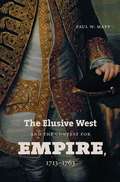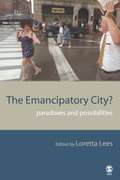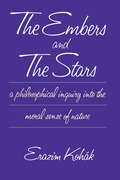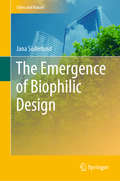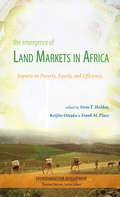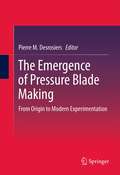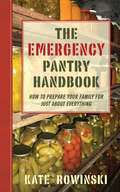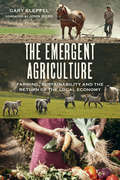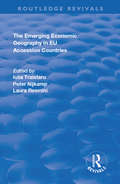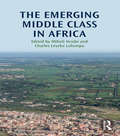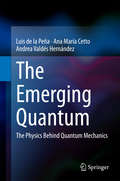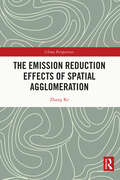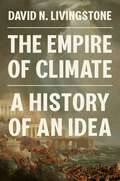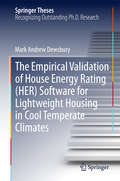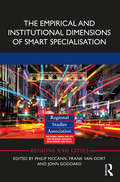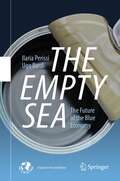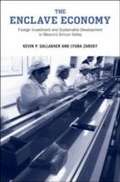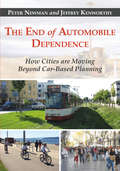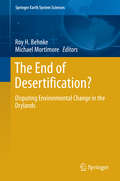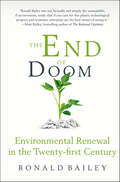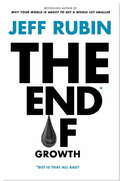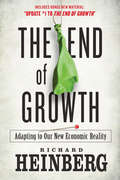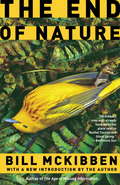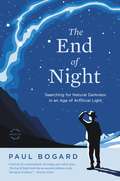- Table View
- List View
The Elusive West and the Contest for Empire, 1713-1763
by Paul W. MappA truly continental history in both its geographic and political scope, The Elusive West and the Contest for Empire, 1713-1763 investigates eighteenth-century diplomacy involving North America and links geographic ignorance about the American West to Europeans' grand geopolitical designs. Breaking from scholars' traditional focus on the Atlantic world, Paul W. Mapp demonstrates the centrality of hitherto understudied western regions to early American history and shows that a Pacific focus is crucial to understanding the causes, course, and consequences of the Seven Years' War.
The Emancipatory City?: Paradoxes and Possibilities
by Loretta Lees'The Emancipatory City is a wonderful addition to a growing literature on the public culture of the city. In these spaces, tolerance and intolerance, difference and indifference, transgressions, resistances, and playful spontaneity erupt to give texture to urban life. The book broadens our gaze and deepens our understanding of how cities enable people to express themselves and be free' - Robert A Beauregard, New School University, New York Who are cities for? What kinds of societies might they most democratically embody? And, how can cities be emancipatory sites? The ambivalent status of urban space in terms of emancipation, democratisation, justice and citizenship is central to recent work in urban geography, `new' cultural geography, critical geography and postmodern planning, as well as literature on urban social justice, public space and the politics of identity. Seeking alternative and progressive visions of the emancipatory city through an exploration of the tensions and possibilities between the freedoms and constraints offered by the city, the authors of The Emancipatory City? build on this wealth of current perspectives to present an critical analysis of urban experience.
The Embers and the Stars: A Philosophical Inquiry into the Moral Sense of Nature
by Erazim Kohák"It is hard to put this profound book into a category. Despite the author's criticisms of Thoreau, it is more like Walden than any other book I have read. . . . The book makes great strides toward bringing the best insights from medieval philosophy and from contemporary environmental ethics together. Anyone interested in both of these areas must read this book."—Daniel A. Dombrowski, The Thomist "Those who share Kohák's concern to understand nature as other than a mere resource or matter in motion will find his temporally oriented interpretation of nature instructive. It is here in particular that Kohák turns moments of experience to account philosophically, turning what we habitually overlook or avoid into an opportunity and basis for self-knowledge. This is an impassioned attempt to see the vital order of nature and the moral order of our humanity as one."—Ethics
The Emergence of Biophilic Design (Cities and Nature)
by Jana SöderlundThis book addresses the emergence of biophilic design, a form of design that looks at people’s intrinsic connection with nature. There is no denying that biophilic design is rapidly expanding globally as an effective response to pressing issues in urban areas and built environments. From being a term few had heard of in 2012, when the author’s research began, to one that is currently trending in a broad range of disciplines, the story of its emergence has never been properly told. The story of the emergence of biophilic design is the story of a social movement and how a gathering of people with a common interest and passion can spark a global trend. The book and the stories within are not only engaging but also informative and educational, offering readers an in-depth understanding of what biophilic design is all about, and how to promote its implementation in their own built environment. Hopefully, they will inspire people to act, to campaign and to implement initiatives in their urban environment, with the confidence that they are capable of making a difference. The author spent three years researching the emergence of biophilic design, and why and how it was driven by certain people who championed the concept. Part of the author’s research involved a three-month tour of ten North American cities, during which she interviewed 26 key players. These people ranged from community leaders, landscape architects, and academics, to the CEOs of NGOs and government leaders. The result is a collection of stories that illustrate the evolution of biophilic design, and how it was frequently born from a passion for, belief in and love of nature, as well as a response to an urban crisis.
The Emergence of Ecological Modernisation: Integrating the Environment and the Economy? (Environmental Politics #1)
by Stephen C. YoungThe Emergence of Ecological Modernisation offers a wealth of empirical research material from an international perspective, bringing together previously scattered sources for the first time. It addresses a series of theoretical issues that are of key contemporary relevance, such as the relationship between ecological modernisation and sustainable development; strategies for promoting ecological modernisation, and the extent to which it is possible to 'green' contemporary capitalism.
The Emergence of Land Markets in Africa: Impacts on Poverty, Equity, and Efficiency (Environment for Development)
by Keijiro Otsuka Stein T. Holden Frank M. PlaceThis book is the first systematic attempt to address emerging land markets and their implications for poverty, equity, and efficiency across a number of African countries. The high incidence of poverty and the need for increased agricultural productivity remain acute in rural areas of sub-Saharan Africa, where a lack of secure land rights and a growing scarcity of land relative to the size of the population are becoming increasingly critical issues. Indeed, land issues in the region are high on the international policy agenda. Yet our knowledge about land tenure security and other rural factor markets (such as labor, oxen, manure, purchased inputs, and credit) is far from adequate to formulate sensible policies. The case studies in the book show that, while land markets and especially informal markets have been rapidly emerging in densely populated parts of Africa - and have generally been to the benefit of the poor--their functions remain imperfect. This is due to policy-induced tenure insecurity and the fragmentation of agricultural land. Applying rigorous quantitative analyses, the book provides a basis for taking into account the role of land markets in national land policies. All too often, the authors argue, land policies have been extreme, either prohibiting all land transactions or giving unrestricted freehold rights to a small elite at the expense of the poor. From the long experience in Asia, it is known that such policies are detrimental to both production efficiency and equity of land use. The authors argue that future policies in Africa should work with the markets. Regulations should be imposed only with careful testing that they are having the intended effects. The Emergence of Land Markets in Africa is a resource for teaching in developed and developing countries, as it provides both comprehensive reviews of the literature and detailed case studies. It is intended to facilitate the dialogue between researchers and policymakers, as well as inspire researchers to go further in their investigations and build an even stronger basis for good policies. The Emergence of Land Markets in Africa is the first publication in the new Environment for Development (EfD) book series. EfD books focus on research and applications in environmental and natural resource economics as they are relevant to poverty reduction and environmental problems in developing countries. The EfD book series is part of the EfD initiative. (www.environmentfordevelopment.org)
The Emergence of Pressure Blade Making
by Pierre M. DesrosiersHuman development is a long and steady process that began with stone tool making. Because of this skill, humans were able to adapt to climate changes, discover new territories, and invent new technologies. "Pressure knapping" is the common term for one method of creating stone tools, where a larger device or blade specifically made for this purpose is use to press out the stone tool. Pressure knapping was invented in different locations and at different points in time, representing the adoption of the Neolithic way of life in the Old world. Recent research on pressure knapping has led for the first time to a global thesis on this technique. The contributors to this seminal work combine research findings on pressure knapping from different cultures around the globe to develope a cohesive theory. This contributions to this volume represents a significant development to research on pressure knapping, as well as the field of lithic studies in general. This work will be an important reference for anyone studying the Paleolithic, Mesolithic, and Neolithic periods, lithic studies, technologies, and more generally, cultural transmission.
The Emergency Pantry Handbook: How to Prepare Your Family for Just about Everything
by Kate Rowinski Jim RowinskiIn today’s world, anything can happen—medical emergencies, power outages, natural disasters. In less time than it takes to sign off on an insurance form, the world as we know it can be brought to a standstill. There can be no question: It’s best to be prepared. The Emergency Pantry Handbook by cooking expert and readiness enthusiast Kate Rowinski offers tips, techniques, and advice on how to keep your family safe, well-fed, and fully supplied in the event of any crisis. With simple instructions, Rowinski demonstrates how to create an emergency strategy; how to protect your house, documents, and keepsakes; and how to prepare for specific disasters. Offering a unique twist on preparation handbooks, Rowinski focuses on food storage and cooking—put simply, how to plan nutritional emergency meals and avoid “making due” on canned meats and chocolate bars. The Emergency Pantry Handbook details:· Storage techniques · Personalizing your food plan · Stockpiling, shelf life, and rotation · Pickling, canning, sprouting, and drying · Making delicious dinners out of your storage pantry Whether a disaster lasts for twenty-four hours or twenty-four weeks, The Emergency Pantry Handbook is the ultimate guide to keeping your family eating healthily and maintaining proper nutrition, even in the worst of circumstances.
The Emergent Agriculture
by Gary Kleppel John IkerdLong embraced by corporations who are driven only by the desire for profit, industrial agriculture wastes precious resources and spews millions of tons of greenhouse gases into the atmosphere each year, exacerbating climate change and threatening the very earth and water on which we depend. However, this dominant system, from which Americans obtain most of their food, is being slowly supplanted by a new paradigm.The Emergent Agriculture is a collection of fourteen thematic essays on sustainability viewed through the lens of farming. Arguing that industrial food production is incompatible with the realities of nature, science, and ethics, this lyrical narrative makes the case for a locally based food system which is: Stable in the face of economic uncertainty Resilient in the face of environmental variability Grounded in stewardship of the land, on attaching value to food and the craft involved in producing it, and on respecting the dignity of farmers, consumer,s and livestockA revolution in food production is underway. Written from the vantage point of an ecologist who is also a farmer, The Emergent Agriculture is essential reading for anyone interested in food security and the potential for growing local economies. Food for thought about the future of food.Gary Kleppel is a professor of biology at the SUNY Albany, where he focuses on sustainable agriculture, conservation-based grazing, and the ecology of human-dominated landscapes. He and his wife Pam are owners of Longfield Farm, where they produce grass-fed lamb, wool, free range chickens and eggs, and artisanal breads.
The Emerging Economic Geography in EU Accession Countries (Routledge Revivals)
by Peter NijkampThis title was first published in 2003. Since 1990, Central and Eastern European countries have experienced increased economic integration with the European Union. The spatial implications of this process have been little investigated so far. Have patterns of regional specialization and industrial concentration changed during the 1990s? How does regional specialization relate to economic performance? How has access to Western markets affected the regional wage structure? What types of regions are winners and what types of regions are losers? This book poses and answers such policy relevant questions. It is organized into three parts. The first introduces the main features of economic integration and transition processes in Central and Eastern Europe and discusses the theoretical and methodological framework of the research. The second part examines the cases of five countries: Bulgaria, Estonia, Hungary, Romania and Slovenia, and the final part includes three comparative analyses which explain the underlying factors that determine the changing patterns of location of manufacturing activity, the adjustment pattern of regional wages and adaptation processes in border regions in the five countries.
The Emerging Middle Class in Africa
by Mthuli Ncube Charles Leyeka LufumpaThe emergence of the African middle class as a driver of Africa’s economic growth stands out as an important milestone in Africa’s contemporary economic history. This growth, though uneven, is a source of hope for Africa, but also a signal to the rest of the world on the prospects for economic recovery and renewal, particularly because it has been steady despite the global downturn. The Emerging Middle Class in Africa analyses specific aspects of the lives of the middle class in Africa. It looks at how people become and remain in the middle class through a series of thematic chapters. It examines how behaviour changes in the process, in terms of consumption patterns and spending on health and education. A further dimension of this analysis is how class impacts on gender relations and whether women are able to reap the same benefits of social advancement available to men. Africa is a continent of such scale and diversity that experiences across countries vary widely. The book thus captures the common patterns across the continent. This text is primarily aimed at Africanist researchers, policy makers, development practitioners, and bilateral and multilateral institutions, as well as students of African studies, political science, political economy, development studies, and development economics.
The Emerging Quantum
by Luis de la Peña Ana María Cetto Andrea Valdés HernándezThis monograph presents the latest findings from a long-term research project intended to identify the physics behind Quantum Mechanics. A fundamental theory for quantum mechanics is constructed from first physical principles, revealing quantization as an emergent phenomenon arising from a deeper stochastic process. As such, it offers the vibrant community working on the foundations of quantum mechanics an alternative contribution open to discussion. The book starts with a critical summary of the main conceptual problems that still beset quantum mechanics. The basic consideration is then introduced that any material system is an open system in permanent contact with the random zero-point radiation field, with which it may reach a state of equilibrium. Working from this basis, a comprehensive and self-consistent theoretical framework is then developed. The pillars of the quantum-mechanical formalism are derived, as well as the radiative corrections of nonrelativistic QED, while revealing the underlying physical mechanisms. The genesis of some of the central features of quantum theory is elucidated, such as atomic stability, the spin of the electron, quantum fluctuations, quantum nonlocality and entanglement. The theory developed here reaffirms fundamental scientific principles such as realism, causality, locality and objectivity.
The Emission Reduction Effects of Spatial Agglomeration (China Perspectives)
by Zhang KeThe book studies the relationship between economic agglomeration and environmental pollution from a spatial perspective through theoretical analyses and empirical discussions.At both microscopic and macroscopic levels, the author first explores the impact mechanism of the agglomeration of economic activities on environmental pollution and proposes research frameworks based on spatial economic theory and output density theory. Drawing on descriptive statistics and explorative spatial data from 283 cities in China, the book investigates the current development, spatial characteristics, influence path, and environmental efficiency of urban economic agglomeration and pollution in the People’s Republic. The following empirical sections study spatial spillover effects, simultaneous bias and spatial interaction between agglomeration and pollution. The research findings give insight into interregional economic development, joint pollution control across regions, and the coordination of the two, especially in the context of developing countries.The title will appeal to researchers, students, government officials and policymakers interested in development economics, regional economics, urban economics, and environmental economics.
The Empire of Climate: A History of an Idea
by David N. LivingstoneHow the specter of climate has been used to explain history since antiquityScientists, journalists, and politicians increasingly tell us that human impacts on climate constitute the single greatest threat facing our planet and may even bring about the extinction of our species. Yet behind these anxieties lies an older, much deeper fear about the power that climate exerts over us. The Empire of Climate traces the history of this idea and its pervasive influence over how we interpret world events and make sense of the human condition, from the rise and fall of ancient civilizations to the afflictions of the modern psyche.Taking readers from the time of Hippocrates to the unfolding crisis of global warming today, David Livingstone reveals how climate has been critically implicated in the politics of imperial control and race relations; been used to explain industrial development, market performance, and economic breakdown; and served as a bellwether for national character and cultural collapse. He examines how climate has been put forward as an explanation for warfare and civil conflict, and how it has been identified as a critical factor in bodily disorders and acute psychosis.A panoramic work of scholarship, The Empire of Climate maps the tangled histories of an idea that has haunted our collective imagination for centuries, shedding critical light on the notion that everything from the wealth of nations to the human mind itself is subject to climate&’s imperial rule.
The Empirical Validation of House Energy Rating (HER) Software for Lightweight Housing in Cool Temperate Climates
by Mark Andrew DewsburyThis book reports on the first empirical validation of "AccuRate," Australia's national benchmark software tool for house energy ratings. The validation was conducted by the University of Tasmania in collaboration with Forest and Wood Products Australia, the Australian Government, the CSIRO and industry partners. The study presented here describes the results of graphical and statistical analysis of variations observed between the measured and simulated data from three different test buildings in Launceston, Tasmania. It shows that, while the AccuRate software is well suited to modeling energy flows, there are discrepancies between the simulated and measured temperatures of the test buildings. Moreover, it highlights possible connections between the discrepancies in all zones and the outside air temperature, wind speed, global and diffuse solar radiation, and possibly the ground model. Beyond its contribution to further investigations into the ongoing improvement and calibration of the Australian NatHERS-supported AccuRate software, this book also meticulously describes the methodology used in conducting the research, which is expected to pave the way for further studies of this type.
The Empirical and Institutional Dimensions of Smart Specialisation (Regions and Cities)
by John Goddard Philip McCann Frank Van OortSmart specialisation is the new policy approach to the development of regional innovation systems across Europe and it involves fostering innovative and entrepreneurial initiatives which are well tailored to the local context. The different technologies, skills profiles, business activities, institutions and sectors which reflect a region’s economic strengths and potential are to be fostered and encouraged to diversify in ways which also exploit the region’s linkages with broader global value-chains.Yet, the ideas contained in the smart specialisation agenda have until now been primarily conceptual in nature. The Empirical and Institutional Dimensions of Smart Specialisation draws together some of the leading regional economists and scientists in Europe to analyse how smart specialisation is working in practice. This book investigates different dimensions of the agenda as it is developing across parts of Europe from both quantitative and qualitative perspectives. The quantitative analysis examines the nature of the diversification processes undertaken by regions and the interplay between the chosen local regional development priorities and the wider global value-chain impacts of these choices. Meanwhile, the qualitative analysis examines the institutional opportunities and challenges facing policy makers and the key elements most likely to provide the underpinnings of a workable set of policy settings.The book is aimed both at academic researchers interested in the interface between economic geography and regional innovation systems as well as at policy makers making public policy decisions related to regional development at the local, city, regional or national levels.
The Empty Sea: The Future of the Blue Economy
by Ugo Bardi Ilaria PerissiThe “Blue Economy” is used to describe all of the economic activities related to the sea, with a special emphasis on sustainability. Traditional activities such as fisheries, but also undersea mining, tourism, and scientific research are included, as well as the phenomenal growth of aquaculture during the past decade. All of these activities, and the irresistible prospect of another new frontier, has led to enthusiastic and, most likely, overenthusiastic assessments of the possibilities to exploit the sea to feed the world, provide low-cost energy, become a new source of minerals, and other future miracles. This book makes sense of these trends and of the future of the blue economy by following our remote ancestors who gradually discovered the sea and its resources, describing the so-called fisherman’s curse – or why fishermen have always been poor, explaining why humans tend to destroy the resources on which we depend, and assessing the realistic expectations for extracting resources from the sea. Although the sea is not so badly overexploited as the land, our demands on ecosystem services are already above the oceans’ sustainability limits. Some new ideas, including “fishing down” for untapped resources such as plankton, could lead to the collapse of the entire marine ecosystem. How Neanderthals crossed the sea in canoes, how it was possible for five men on a small boat to kill a giant whale, what kind of oil the virgins of the Gospel put into their lamps, how a professor of mathematics, Vito Volterra, discovered the “equations of fishing,” why it has become so easy to be stung by a jellyfish while swimming in the sea, and how to play “Moby Dick,” a simple board game that simulates the overexploitation of natural resources are just some of the questions that you will be able to answer after reading this engaging and insightful book about the rapidly expanding relationship between humanity and the sea.
The Enclave Economy: Foreign Investment and Sustainable Development in Mexico's Silicon Valley
by Lyuba Zarsky Kevin P. GallagherForeign investment has been widely perceived as a panacea for developing countries--as a way to reduce poverty and jump-start sustainable modern industries. In The Enclave Economy,Kevin Gallagher and Lyuba Zarsky call this prescription into question, showing that Mexico's post-NAFTA experience of foreign direct investment in its information technology sector, particularly in the Guadalajara region, did not result in the expected benefits. Charting the rise and fall of Mexico's "Silicon Valley," they explore issues that resonate through much of Latin America and the developing world: the social, economic, and environmental effects of market-driven globalization. In the 1990s, Mexico was a poster child for globalization, throwing open its borders to trade and foreign investment, embracing NAFTA, and ending the government's role in strengthening domestic industry. But The Enclave Economyshows that although Mexico was initially successful in attracting multinational corporations, foreign investments waned in the absence of active government support and because China became increasingly competitive. Moreover, foreign investment created an "enclave economy" the benefits of which were confined to an international sector not connected to the wider Mexican economy. In fact, foreign investment put many local IT firms out of business and transferred only limited amounts of environmentally sound technology. Gallagher and Zarsky suggest policies and strategies that will enable Mexico and other developing countries to foster foreign investment for sustainable development in the future.
The End of Automobile Dependence
by Jeffrey Kenworthy Peter NewmanCities will continue to accommodate the automobile, but when cities are built around them, the quality of human and natural life declines. Current trends show great promise for future urban mobility systems that enable freedom and connection, but not dependence. We are experiencing the phenomenon of peak car use in many global cities at the same time that urban rail is thriving, central cities are revitalizing, and suburban sprawl is reversing. Walking and cycling are growing in many cities, along with ubiquitous bike sharing schemes, which have contributed to new investment and vitality in central cities including Melbourne, Seattle, Chicago, and New York. We are thus in a new era that has come much faster than global transportation experts Peter Newman and Jeffrey Kenworthy had predicted: the end of automobile dependence. In The End of Automobile Dependence, Newman and Kenworthy look at how we can accelerate a planning approach to designing urban environments that can function reliably and conveniently on alternative modes, with a refined and more civilized automobile playing a very much reduced and manageable role in urban transportation. The authors examine the rise and fall of automobile dependence using updated data on 44 global cities to better understand how to facilitate and guide cities to the most productive and sustainable outcomes. This is the final volume in a trilogy by Newman and Kenworthy on automobile dependence (Cities and Automobile Dependence in 1989 and Sustainability and Cities: Overcoming Automobile Dependence in 1999). Like all good trilogies this one shows the rise of an empire, in this case that of the automobile, the peak of its power, and the decline of that empire.
The End of Desertification?
by Roy Behnke Michael MortimoreThe question in the title of this book draws attention to the shortcomings of a concept that has become a political tool of global importance even as the scientific basis for its use grows weaker. The concept of desertification, it can be argued, has ceased to be analytically useful and distorts our understanding of social-environmental systems and their resiliency, particularly in poor countries with variable rainfall and persistent poverty. For better policy and governance, we need to reconsider the scientific justification for international attempts to combat desertification. Our exploration of these issues begins in the Sahel of West Africa, where a series of severe droughts at the end of the 20th century led to the global institutionalization of the idea of desertification. It now seems incontrovertible that these droughts were not caused primarily by local land use mismanagement, effectively terminating a long-standing policy and scientific debate. There is now an opportunity to treat this episode as an object lesson in the relationship between science, the formation of public opinion and international policy-making. Looking beyond the Sahel, the chapters in this book provide case studies from around the world that examine the use and relevance of the desertification concept. Despite an increasingly sophisticated understanding of dryland environments and societies, the uses now being made of the desertification concept in parts of Asia exhibit many of the shortcomings of earlier work done in Africa. It took scientists more than three decades to transform a perceived desertification crisis in the Sahel into a non-event. This book is an effort to critically examine that experience and accelerate the learning process in other parts of the world.
The End of Doom: Environmental Renewal in the Twenty-first Century
by Ronald BaileyIn the past five decades there have been many, many forecasts of impending environmental doom. They have universally been proven wrong. Meanwhile, those who have bet on human resourcefulness have almost always been correct. In his widely praised book Ecoscam, Ronald Bailey strongly countered environmentalist alarmism, using facts to demonstrate just how wildly overstated many claims of impending ecological doom really were. Now, twenty years later, the Reason Magazine science correspondent is back to assess the future of humanity and the global biosphere. Bailey finds, contrary to popular belief, that many present ecological trends are quite positive. Including: Falling cancer incidence rates in the United States. The likelihood of a declining world population by mid-century. The abundant return of agricultural land to nature as the world reaches peak farmland. A proven link between increases in national wealth and reductions in air and water pollution Global warming is a problem, but the cost of clean energy could soon fall below that of fossil fuels.In The End of Doom, Bailey avoids polemics and offers a balanced, fact-based and ultimately hopeful perspective on our current environmental situation. Now isn't that a breath of fresh air?
The End of Growth
by Jeff RubinIn an urgent follow-up to his best-selling Why Your World Is About To Get A Whole Lot Smaller, Jeff Rubin argues that the end of cheap oil means the end of growth. What it will be like to live in a world where growth is over? Economist and resource analyst Jeff Rubin is certain that the world's governments are getting it wrong. Instead of moving us toward economic recovery, measures being taken around the globe right now are digging us into a deeper hole. Both politicians and economists are missing the fact that the real engine of economic growth has always been cheap, abundant fuel and resources. But that era is over. The end of cheap oil, Rubin argues, signals the end of growth--and the end of easy answers to renewing prosperity. Rubin's own equation is clear: with China and India sucking up the lion's share of the world's ever more limited resources, the rest of us will have to make do with less. But is this all bad? Can less actually be more? Rubin points out that there is no research to show that people living in countries with hard-charging economies are happier, and plenty of research to show that some of the most contented people on the planet live in places with no-growth or slow-growth GDPs. But it doesn't matter whether it's bad or good, it's the new reality: our world is not only about to get smaller, our day-to-day lives are about to be a whole lot different.
The End of Growth
by Richard HeinbergThis special, updated ebook edition includes new bonus material.Economists insist that recovery is at hand, yet unemployment remains high, real estate values continue to sink, and governments stagger under record deficits. The End of Growth proposes a startling diagnosis: humanity has reached a fundamental turning point in its economic history. The expansionary trajectory of industrial civilization is colliding with non-negotiable natural limits.Richard Heinberg's latest landmark work goes to the heart of the ongoing financial crisis, explaining how and why it occurred, and what we must do to avert the worst potential outcomes. Written in an engaging, highly readable style, it shows why growth is being blocked by three factors:--Resource depletion--Environmental impacts--Crushing levels of debtThese converging limits will force us to re-evaluate cherished economic theories and to reinvent money and commerce.The End of Growth describes what policy makers, communities, and families can do to build a new economy that operates within Earth's budget of energy and resources. We can thrive during the transition if we set goals that promote human and environmental well-being, rather than continuing to pursue the now-unattainable prize of ever-expanding GDP.Richard Heinberg is the author of nine previous books, including The Party's Over, Peak Everything, and Blackout. A senior fellow of the Post Carbon Institute, Heinberg is one of the world's foremost peak oil educators and an effective communicator of the urgent need to transition away from fossil fuels.
The End of Nature
by Bill MckibbenReissued on the tenth anniversary of its publication, this classic work on our environmental crisis features a new introduction by the author, reviewing both the progress and ground lost in the fight to save the earth.This impassioned plea for radical and life-renewing change is today still considered a groundbreaking work in environmental studies. McKibben's argument that the survival of the globe is dependent on a fundamental, philosophical shift in the way we relate to nature is more relevant than ever. McKibben writes of our earth's environmental cataclysm, addressing such core issues as the greenhouse effect, acid rain, and the depletion of the ozone layer. His new introduction addresses some of the latest environmental issues that have risen during the 1990s. The book also includes an invaluable new appendix of facts and figures that surveys the progress of the environmental movement.More than simply a handbook for survival or a doomsday catalog of scientific prediction, this classic, soulful lament on Nature is required reading for nature enthusiasts, activists, and concerned citizens alike.
The End of Night: Searching for Natural Darkness in an Age of Artificial Light
by Paul BogardA deeply panoramic tour of the night, from its brightest spots to the darkest skies we have left. A starry night is one of nature's most magical wonders. Yet in our artificially lit world, three-quarters of Americans' eyes never switch to night vision and most of us no longer experience true darkness. In THE END OF NIGHT, Paul Bogard restores our awareness of the spectacularly primal, wildly dark night sky and how it has influenced the human experience across everything from science to art. From Las Vegas' Luxor Beam--the brightest single spot on this planet--to nights so starlit the sky looks like snow, Bogard blends personal narrative, natural history, science, and history to shed light on the importance of darkness--what we've lost, what we still have, and what we might regain--and the simple ways we can reduce the brightness of our nights tonight.
